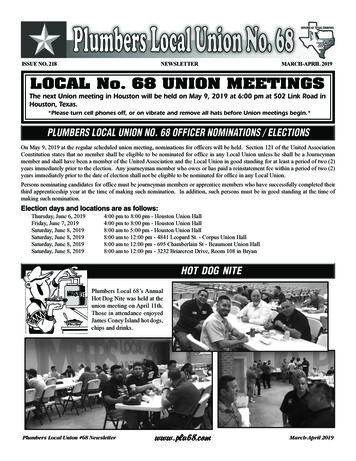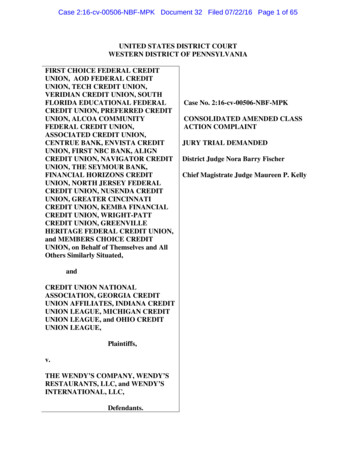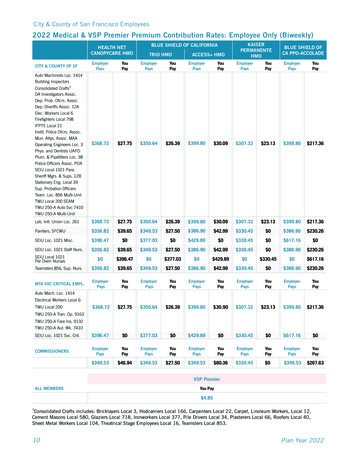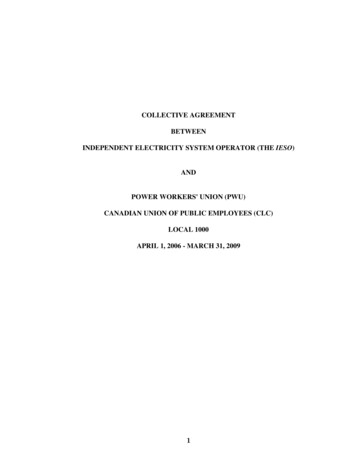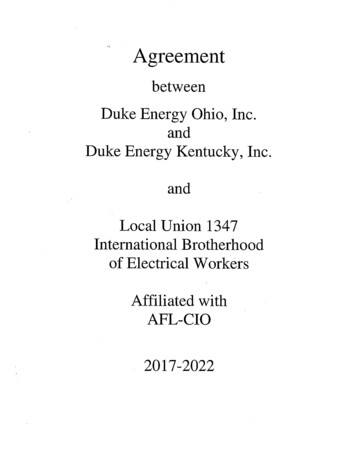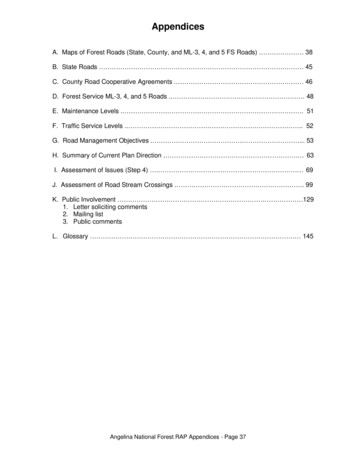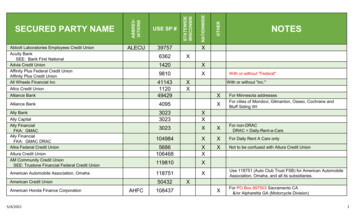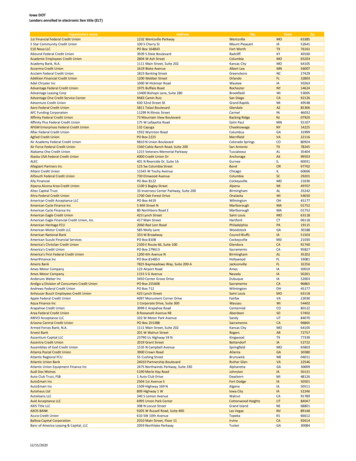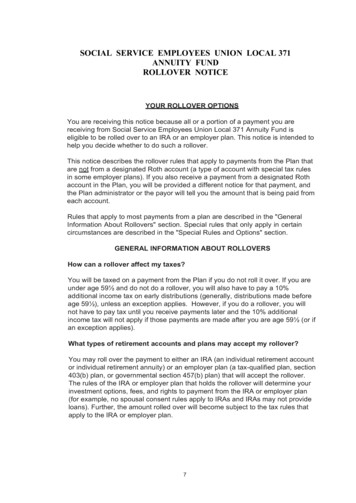
Transcription
SOCIAL SERVICE EMPLOYEES UNION LOCAL 371ANNUITY FUNDROLLOVER NOTICEYOUR ROLLOVER OPTIONSYou are receiving this notice because all or a portion of a payment you arereceiving from Social Service Employees Union Local 371 Annuity Fund iseligible to be rolled over to an IRA or an employer plan. This notice is intended tohelp you decide whether to do such a rollover.This notice describes the rollover rules that apply to payments from the Plan thatare not from a designated Roth account (a type of account with special tax rulesin some employer plans). If you also receive a payment from a designated Rothaccount in the Plan, you will be provided a different notice for that payment, andthe Plan administrator or the payor will tell you the amount that is being paid fromeach account.Rules that apply to most payments from a plan are described in the "GeneralInformation About Rollovers" section. Special rules that only apply in certaincircumstances are described in the "Special Rules and Options" section.GENERAL INFORMATION ABOUT ROLLOVERSHow can a rollover affect my taxes?You will be taxed on a payment from the Plan if you do not roll it over. If you areunder age 59½ and do not do a rollover, you will also have to pay a 10%additional income tax on early distributions (generally, distributions made beforeage 59½), unless an exception applies. However, if you do a rollover, you willnot have to pay tax until you receive payments later and the 10% additionalincome tax will not apply if those payments are made after you are age 59½ (or ifan exception applies).What types of retirement accounts and plans may accept my rollover?You may roll over the payment to either an IRA (an individual retirement accountor individual retirement annuity) or an employer plan (a tax-qualified plan, section403(b) plan, or governmental section 457(b) plan) that will accept the rollover.The rules of the IRA or employer plan that holds the rollover will determine yourinvestment options, fees, and rights to payment from the IRA or employer plan(for example, no spousal consent rules apply to IRAs and IRAs may not provideloans). Further, the amount rolled over will become subject to the tax rules thatapply to the IRA or employer plan.7
How do I do a rollover?There are two ways to do a rollover. You can do either a direct rollover or a 60day rollover.If you do a direct rollover, the Plan will make the payment directly to your IRA oran employer plan. You should contact the IRA sponsor or the administrator ofthe employer plan for information on how to do a direct rollover.If you do not do a direct rollover, you may still do a rollover by making a depositinto an IRA or eligible employer plan that will accept it. Generally, you will have60 days after you receive the payment to make the deposit. If you do not do adirect rollover, the Plan is required to withhold 20% of the payment for federalincome taxes (up to the amount of cash and property received other thanemployer stock). This means that, in order to roll over the entire payment in a60-day rollover, you must use other funds to make up for the 20% withheld. Ifyou do not roll over the entire amount of the payment, the portion not rolled overwill be taxed and will be subject to the 10% additional income tax on earlydistributions if you are under age 59½ (unless an exception applies).How much may I roll over?If you wish to do a rollover, you may roll over all or part of the amount eligible forrollover. Any payment from the Plan is eligible for rollover, except: Certain payments spread over a period of at least 10 years or over yourlife or life expectancy (or the lives or joint life expectancy of you and yourbeneficiary);Required minimum distributions after age 70½ (or after death);Hardship distributions;ESOP dividends;Corrective distributions of contributions that exceed tax law limitations;Loans treated as deemed distributions (for example, loans in default dueto missed payments before your employment ends);Cost of life insurance paid by the Plan;Payments of certain automatic enrollment contributions requested to bewithdrawn within 90 days of the first contribution; andAmounts treated as distributed because of a prohibited allocation ofS corporation stock under an ESOP (also, there will generally be adversetax consequences if you roll over a distribution of S corporation stock to anIRA),.The Plan administrator or the payor can tell you what portion of a payment iseligible for rollover.8
If I don't do a rollover, will I have to pay the 10% additional Income tax onearly distributions?If you are under age 59½, you will have to pay the 10% additional income tax onearly distributions for any payment from the Plan (including amounts withheld forincome tax) that you do not roll over, unless one of the exceptions listed belowapplies. This tax applies to the part of the distribution that you must include inincome and is in addition to the regular income tax on the payment not rolledover.The 10% additional income tax does not apply to the following payments from thePlan: Payments made after you separate from service if you will be at least age55 in the year of the separation;Payments that start after you separate from service if paid at leastannually in equal or close to equal amounts over your life or lifeexpectancy (or the lives or joint life expectancy of you and yourbeneficiary);Payments from a governmental plan made after you separate from serviceif you are a qualified public safety employee and you will be at least age50 in the year of the separation;Payments made due to disability;Payments after your death;Payments of ESOP dividends;Corrective distributions of contributions that exceed tax law limitations;Cost of life insurance paid by the Plan;Payments made directly to the government to satisfy a federal tax levy;Payments made under a qualified domestic relations order (QDRO);Payments up to the amount of your deductible medical expenses (withoutregard to whether you itemize deductions for the taxable year);Certain payments made while you are on active duty if you were amember of a reserve component called to duty after September 11, 2001for more than 179 days;Payments of certain automatic enrollment contributions requested to bewithdrawn within 90 days of the first contribution;Payments for certain distributions relating to certain federally declareddisasters; andPhased retirement payments made to federal employees.If I do a rollover to an IRA, will the 10% additional income tax apply to earlydistributions from the IRA?If you receive a payment from an IRA when you are under age 59½, you willhave to pay the 10% additional income tax on early distributions on the part ofthe distribution that you must include in income, unless an exception applies. In9
general, the exceptions to the 10% additional income tax for early distributionsfrom an IRA are the same as the exceptions listed above for early distributionsfrom a plan. However, there are a few differences for payments from an IRA,including: The exception for payments made after you separate from service if youwill be at least age 55 in the year of the separation (or age 50 for qualifiedpublic safety employees) does not apply.The exception for qualified domestic relations orders (QDROs) does notapply (although a special rule applies under which, as part of a divorce orseparation agreement, a tax-free transfer may be made directly to an IRAof a spouse or former spouse).The exception for payments made at least annually in equal or close toequal amounts over a specified period applies without regard to whetheryou have had a separation from service.There are additional exceptions for (1) payments for qualified highereducation expenses, (2) payments up to 10,000 used in a qualified first time home purchase, and (3) payments for health insurance premiumsafter you have received unemployment compensation for 12 consecutiveweeks (or would have been eligible to receive unemploymentcompensation but for self-employed status).Will I owe State income taxes?This notice does not describe any State or local income tax rules (includingwithholding rules).SPECIAL RULES AND OPTIONSIf your payment includes after-tax contributionsAfter-tax contributions included in a payment are not taxed. If a payment is onlypart of your benefit, an allocable portion of your after-tax contributions is includedin the payment, so you cannot take a payment of only after-tax contributions.However, if you have pre-1987 after-tax contributions maintained in a separateaccount, a special rule may apply to determine whether the after-taxcontributions are included in a payment. In addition, special rules apply whenyou do a rollover, as described below.You may roll over to an IRA a payment that includes after-tax contributionsthrough either a direct rollover or a 60-day rollover. You must keep track of theaggregate amount of the after-tax contributions in all of your IRAs (in order todetermine your taxable income for later payments from the IRAs). If you do adirect rollover of only a portion of the amount paid from the Plan and at the sametime the rest is paid to you, the portion directly rolled over consists first of theamount that would be taxable if not rolled over. For example, assume you are10
receiving a distribution of 12,000, of which 2,000 is after-tax contributions. Inthis case, if you directly roll over 10,000 to an IRA that is not a Roth IRA, noamount is taxable because the 2,000 amount not directly rolled over is treatedas being after-tax contributions. If you do a direct rollover of the entire amountpaid from the Plan to two or more destinations at the same time, you can choosewhich destination receives the after-tax contributions.If you do a 60-day rollover to an IRA of only a portion of a payment made to you,the after-tax contributions are treated as rolled over last. For example, assumeyou are receiving a distribution of 12,000, of which 2,000 is after-taxcontributions, and no part of the distribution is directly rolled over. In this case, ifyou roll over 10,000 to an IRA that is not a Roth IRA in a 60-day rollover, noamount is taxable because the 2,000 amount not rolled over is treated as beingafter-tax contributions.You may roll over to an employer plan all of a payment that includes after-taxcontributions, but only through a direct rollover (and only if the receiving planseparately accounts for after-tax contributions and is not a governmentalsection 457(b) plan). You can do a 60-day rollover to an employer plan of part ofa payment that includes after-tax contributions, but only up to the amount of thepayment that would be taxable if not rolled over.If you miss the 60-day rollover deadlineGenerally, the 60-day rollover deadline cannot be extended. However, the IRShas the limited authority to waive the deadline under certain extraordinarycircumstances, such as when external events prevented you from completing therollover by the 60-day rollover deadline. Under certain circumstances, you mayclaim eligibility for a waiver of the 60-day rollover deadline by making a writtenself-certification. Otherwise, to apply for a waiver from the IRS, you must file aprivate letter ruling request with the IRS. Private letter ruling requests require thepayment of a nonrefundable user fee. For more information, see IRS Publication590-A, Contributions to Individual Retirement Arrangements (IRAs).If your payment includes employer stock that you do not roll overIf you do not do a rollover, you can apply a special rule to payments of employerstock (or other employer securities) that are either attributable to after-taxcontributions or paid in a lump sum after separation from service (or after age59½, disability, or the participant's death). Under the special rule, the netunrealized appreciation on the stock will not be taxed when distributed from thePlan and will be taxed t capital gain rates when you sell the stock. Netunrealized appreciation is generally the increase in the value of employer stockafter it was acquired by the Plan. If you do a rollover for a payment that includesemployer stock (for example, by selling the stock and rolling over the proceedswithin 60 days of the payment), the special rule relating to the distributed11
employer stock will not apply to any subsequent payments from the IRA oremployer plan. The Plan administrator can tell you the amount of any netunrealized appreciation.If you have an outstanding loan that is being offsetIf you have an outstanding loan from the Plan, your Plan benefit may be offset bythe outstanding amount of the loan, typically when your employment ends. Theoffset amount is treated as a distribution to you at the time of the offset.Generally, you may roll over all or any portion of the offset amount. Any offsetamount that is not rolled over will be taxed (including the 10% additional incometax on early distributions, unless an exception applies). You may roll over offsetamounts to an IRA or an employer plan (if the terms of the employer plan permitthe plan to receive plan loan offset rollovers).How long you have to complete the rollover depends on what kind of plan loanoffset you have. If you have a qualified plan loan offset, you will have until yourtax return due date (including extensions) for the tax year during which the offsetoccurs to complete your rollover. A qualified plan loan offset occurs when a planloan in good standing is offset because your employer plan terminates, orbecause you sever from employment. If your plan loan offset occurs for anyother reason, then you have 60 days from the date the offset occurs to completeyour rollover.If you were born on or before January 1, 1936If you were born on or before January 1, 1936 and receive a lump sumdistribution that you do not roll over, special rules for calculating the amount ofthe tax on the payment might apply to you. For more information, see IRSPublication 575, Pension and Annuity Income.If your payment is from a governmental section 457(b) planIf the Plan is a governmental section 457(b) plan, the same rules describedelsewhere in this notice generally apply, allowing you to roll over the payment toan IRA or an employer plan that accepts rollovers. One difference is that, if youdo not do a rollover, you will not have to pay the 10% additional income tax onearly distributions from the Plan even if you are under age 59½ (unless thepayment is from a separate account holding rollover contributions that weremade to the Plan from a tax-qualified plan, a section 403(b) plan, or an IRA).However, if you do a rollover to an IRA or to an employer plan that is not agovernmental section 457(b) plan, a later distribution made before age 59½ willbe subject to the 10% additional income tax on early distributions (unless anexception applies). Other differences include that you cannot do a rollover if thepayment is due to an "unforeseeable emergency" and the special rules under "If12
your payment includes employer stock that you do not roll over and "If you wereborn on or before January 1, 1936" do not apply.If you are an eligible retired public safety officer and your payment is usedto pay for health coverage or qualified long-term care insuranceIf the Plan is a governmental plan, you retired as a public safety officer, and yourretirement was by reason of disability or was after normal retirement age, youcan exclude from your taxable income Plan payments paid directly as premiumsto an accident or health plan (or a qualified long-term care insurance contract)that your employer maintains for you, your spouse, or your dependents, up to amaximum of 3,000 annually. For this purpose, a public safety officer is a lawenforcement officer, firefighter, chaplain, or member of a rescue squad orambulance crew.If you roll over your payment to a Roth IRAIf you roll over a payment from the Plan to a Roth IRA, a special rule appliesunder which the amount of the payment rolled over (reduced by any after-taxamounts) will be taxed. However, the 10% additional income tax on earlydistributions will not apply (unless you take the amount rolled over out of the RothIRA within 5 years, counting from January 1 of the year of the rollover).If you roll over the payment to a Roth IRA, later payments from the Roth IRA thatare qualified distributions will not be taxed (including earnings after the rollover).A qualified distribution from a Roth IRA is a payment made after you are age59½ (or after your death or disability, or as a qualified first-time homebuyerdistribution of up to 10,000) and after you have had a Roth IRA for at least 5years. In applying this 5-year rule, you count from January 1 of the year forwhich your first contribution was made to a Roth IRA. Payments from the RothIRA that are not qualified distributions will be taxed to the extent of earnings afterthe rollover, including the 10% additional income tax on early distributions(unless an exception applies). You do not have to take required minimumdistributions from a Roth IRA during your lifetime. For more information, see IRSPublication 590-A, Contributions to Individual Retirement Arrangements (IRAs),and IRS Publication 590-B, Distributions from Individual RetirementArrangements (IRAs).If you do a rollover to a designated Roth account in the PlanYou cannot roll over a distribution to a designated Roth account in anotheremployer's plan. However, you can roll the distribution over into a designatedRoth account in the distributing Plan. If you roll over a payment from the Plan toa designated Roth account in the Plan, the amount of the payment rolled over(reduced by any after-tax amounts directly rolled over) will be taxed. However,the 10% additional tax on early distributions will not apply (unless you take the13
amount rolled over out of the designated Roth account within the 5-year periodthat begins on January 1 of the year of the rollover).If you roll over the payment to a designated Roth account in the Plan, laterpayments from the designated Roth account that are qualified distributions willnot be taxed (including earnings after the rollover). A qualified distribution from adesignated Roth account is a payment made both after you are age 59½ (or afteryour death or disability) and after you have had a designated Roth account in thePlan for at least 5 years. In applying this 5-year rule, you count from January 1of the year your first contribution was made to the designated Roth account.However, if you made a direct rollover to a designated Roth account in the Planfrom a designated Roth account in a plan of another employer, the 5-year periodbegins on January 1 of the year you made the first contribution to the designatedRoth account in the Plan or, if earlier, to the designated Roth account in the planof the other employer. Payments from the designated Roth account that are notqualified distributions will be taxed to the extent of earnings after the rollover,including the 10% additional income tax on early distributions (unless anexception applies).If you are not a Plan participantPayments after death of the participant. If you receive a distribution after theparticipant's death that you do not roll over, the distribution will generally betaxed in the same manner described elsewhere in this notice. However, the 10%additional income tax on early distributions and the special rules for public safetyofficers do not apply, and the special rule described under the section "If youwere born on or before January 1, 1936" applies only if the participant was bornon or before January 1, 1936.If you are a surviving spouse. If you receive a payment from the Planas the surviving spouse of a deceased participant, you have the samerollover options that the participant would have had, as describedelsewhere in this notice. In addition, if you choose to do a rollover to anIRA, you may treat the IRA as your own or as an inherited IRA.An IRA you treat as your own is treated like any other IRA of yours, so thatpayments made to you before you are age 59½ will be subject to the 10%additional income tax on early distributions (unless an exception applies)and required minimum distributions from your IRA do not have to start untilafter you are age 70½.If you treat the IRA as an inherited IRA, payments from the IRA will not besubject to the 10% additional income tax on early distributions. However,if the participant had started taking required minimum distributions, youwill have to receive required minimum distributions from the inherited IRA.If the participant had not started taking required minimum distributions14
from the Plan, you will not have to start receiving required minimumdistributions from the inherited IRA until the year the participant wouldhave been age 70½.If you are a surviving beneficiary other than a spouse. If you receive apayment from the Plan because of the participant's death and you are adesignated beneficiary other than a surviving spouse, the only rolloveroption you have is to do a direct rollover to an inherited IRA. Paymentsfrom the inherited IRA will not be subject to the 10% additional income taxon early distributions. You will have to receive required minimumdistributions from the inherited IRA.Payments under a qualified domestic relations order. If you are the spouse orformer spouse of the participant who receives a payment from the Plan under aqualified domestic relations order (QDRO), you generally have the same optionsand the same tax treatment that the participant would have (for example, youmay roll over the payment to your own IRA or an eligible employer plan that willaccept it). However, payments under the QDRO will not be subject to the 10%additional income tax on early distributions.If you are a nonresident alienIf you are a nonresident alien and you do not do a direct rollover to a U.S. IRA orU.S. employer plan, instead of withholding 20%, the Plan is generally required towithhold 30% of the payment for federal income taxes. If the amount withheldexceeds the amount of tax you owe (as may happen if you do a 60-day rollover),you may request an income tax refund by filing Form 1040NR and attaching yourForm 1042-S. See Form W-8BEN for claiming that you are entitled to a reducedrate of withholding under an income tax treaty. For more information, see alsoIRS Publication 519, U.S. Tax Guide for Aliens, and IRS Publication 515,Withholding of Tax on Nonresident Aliens and Foreign Entities.Other special rulesIf a payment is one in a series of payments for less than 10 years, your choicewhether to make a direct rollover will apply to all later payments in the series(unless you make a different choice for later payments).If your payments for the year are less than 200 (not including payments from adesignated Roth account in the Plan), the Plan is not required to allow you to doa direct rollover and is not required to withhold federal income taxes. However,you may do a 60-day rollover.Unless you elect otherwise, a mandatory cash out of more than 1,000 (notincluding payments from a designated Roth account in the Plan) will be directlyrolled over to an IRA chosen by the Plan administrator or the payor. A15
mandatory cashout is a payment from a plan to a participant made before age 62(or normal retirement age, if later) and without consent, where the participant'sbenefit does not exceed 5,000 (not including any amounts held under the planas a result of a prior rollover made to the plan).You may have special rollover rights if you recently served in the U.S. ArmedForces. For more information on special rollover rights related to the U.S. ArmedForces, see IRS Publication 3, Armed Forces' Tax Guide. You also may havespecial rollover rights if you were affected by a federally declared disaster (orsimilar event), or if you received a distribution on account of a disaster. For moreinformation on special rollover rights related to disaster relief, see the IRSwebsite at www.irs.gov.FOR MORE INFORMATIONYou may wish to consult with the Plan administrator or payor, or a professionaltax advisor, before taking a payment from the Plan. Also, you can find moredetailed information on the federal tax treatment of payments from employerplans in: IRS Publication 575, Pension and Annuity Income; IRS Publication590-A, Contributions to Individual Retirement Arrangements (IRAs); IRSPublication 590-B, Distributions from Individual Retirement Arrangements (IRAs);and IRS Publication 571, Tax-Sheltered Annuity Plans (403(b) Plans). Thesepublications are available from a local IRS office, on the web at www.irs.gov, orby calling 1-800-TAX-FORM.16
ANNUITY FUND . ROLLOVER NOTICE . YOUR ROLLOVER OPTIONS . You are receiving this notice because all or a portion of a payment you are receiving from Social Service Employees Union Local 371 Annuity Fund is eligible to be rolled over to an IRA or an employer plan. This notice is intended to help you decide whether to do such a rollover.
